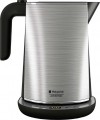Coating of the heating element
The outer covering of the heater is a significant factor in determining the characteristics of the kettle because it is in direct contact with the heated water. Therefore, the material used for this coating is an essential consideration in the kettle's properties.
— Stainless steel. "Stainless steel" is the most commonly used coating for kettles as it is affordable and provides good resistance to scale buildup. However, compared to more advanced materials, it may not offer the highest level of scale resistance.
— Aluminium. Another common material, slightly more expensive and resistant to scale than stainless steel, but in general not having significant differences.
— Silver. Silver is another premium material that has good resistance to both scale and corrosion. In addition, it also possesses some antibacterial properties, making it a suitable choice for those who use the kettle to store cooled boiled water. However, the cost of silver plating is quite high.
Temperature adjustment
The temperature adjustment capabilities refer to the specific temperature values that can be programmed into the electric kettle. It's important to note that this refers to automatic adjustment, where the kettle turns off or switches to temperature maintenance mode once the desired temperature has been reached.
If this paragraph contains several options separated by commas (for example, “60 °С, 80 °С, 90 °С”), this means that this model has several fixed temperature options. However, there are also devices with
smooth adjustment, which allows you to adjust the temperature in steps of 5 °C, or even 1 °C; for such devices, the entire adjustment range is indicated here, for example, "60 — 100 °C".
The greater the number of temperature setting options available in an electric kettle, the more versatile it becomes, allowing for precise selection of the optimal brewing mode for various types of drinks. Here is a simple table of recommended temperatures:
—
white tea — 60 °C;
—
yellow tea -70 °C;
—
green tea — 80 °C;
—
black tea — 90 °C;
— rooibos, hibiscus — 100 °C (up to boiling);
—
baby food — 40 °C.
Of course, there are exceptions to such rules — depending on the specific type of drink. For example, some
...varieties of green tea can be brewed at 90 °C.Maintaining t° (kettle)
The ability to operate a classic kettle (see "Type") in the mode of
maintaining the water temperature — when the heated water is kept hot due to the operation of the heater at low power. For kettles, unlike thermopots, this mode is far from necessary, so its presence is indicated separately in the specs.
Body shape
The general shape of the body of the electric kettle.
—
Conical. The most popular option: a body is wide at the base and tapering upwards. This form contributes to stability: the centre of gravity is maximally displaced downwards. However washing such a kettle from the inside may not be very convenient due to the relatively small size of the opening in the upper part.
—
Cylindrical. The cylindrical shape provides more or less the same width of the body at the base and at the top. With the same height and base diameter, such kettles hold slightly more water than conical ones; in addition, such a device is easier to clean due to the wide opening for the lid.
—
Inclined. The body which is inclined forward; the width of such a body is usually more or less the same over the entire height. Such kettles have an unusual, eye-catching appearance; in addition, it is easier to pour water from them — the device must be inclined at a smaller angle than with a cylindrical and even with a conical body. However, this option does not provide fundamental advantages over the same cylindrical shape, but it is more expensive, and therefore is not common.

